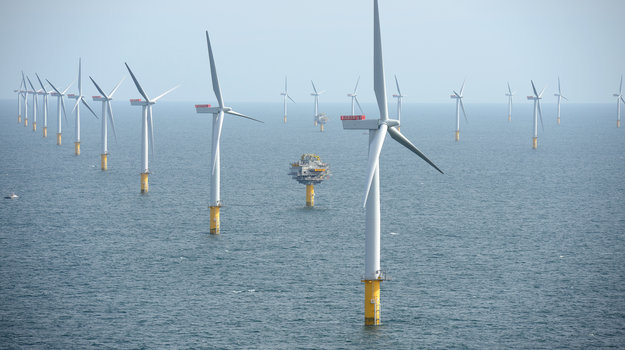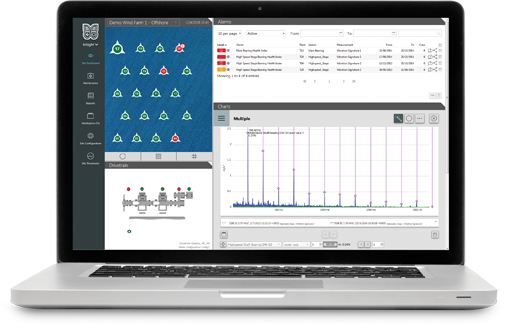Why Turbine Uptime is Crucial for Wind Farm Efficiency
Wind energy is one of the fastest growing sources of energy production globally, projected to provide almost a third of the USA's energy needs by 2050[1]. In order to achieve these projections - and ensure the profitability of their assets - wind farm owners and operators must take advantage of the latest technologies available to them.
Why is turbine uptime important?
A key part of creating efficiencies to ensure profitability is maximizing turbine uptime. This is the core goal of wind turbine operations and maintenance (O&M). Turbine uptime, or availability, involves making sure that the assets on a wind farm are fully functional during critical energy generation periods. Essentially, it means they are working when the wind is high. The costs of failing to maximize turbine uptime can be considerable, and will only increase with the trend for larger turbines.
 The missed potential profit due to the unavailability of a failed turbine can be up to $2,000 per day, per turbine, based on a 4.2MW turbine. With larger turbines, those losses will increase accordingly. The logistical difficulties in some regions of offshore turbine repair mean it can take weeks or months to complete a repair in this environment. With the advent of floating wind farms far out at sea, the complexity of onsite maintenance and repairs will become a greater challenge.
The missed potential profit due to the unavailability of a failed turbine can be up to $2,000 per day, per turbine, based on a 4.2MW turbine. With larger turbines, those losses will increase accordingly. The logistical difficulties in some regions of offshore turbine repair mean it can take weeks or months to complete a repair in this environment. With the advent of floating wind farms far out at sea, the complexity of onsite maintenance and repairs will become a greater challenge.
Bear in mind that these numbers don't include the repairs themselves (the costs for which are considerable due to the hazardous and labor-intensive conditions offshore). Offshore maintenance also involves specialized crew transfer vessels, highly skilled technicians and engineers, and cranes, as well as the replacement parts. Moreover, sending personnel up wind turbines is risky, and should be done only when necessary. All of this not only stretches O&M budgets, but also demands additional planning time from O&M teams.
How predictive maintenance increases turbine uptime
To prevent these costly wind turbine failures, it is necessary to catch problems before they become more serious. The best way to do this is through predictive maintenance, which strikes a balance between the expensive "run to fail" reactive model of O&M, and the preventative maintenance that spends unnecessary money on regularly scheduled replacements.
 Predictive maintenance uses the latest digital technologies to enable a more intelligent, strategic method of O&M. Using cost-effective sensors installed in wind turbines to monitor data streams (including vibration, oil condition and temperature) predictive maintenance providers can train artificial intelligence/machine learning algorithms to spot trends in turbine monitoring data, which could indicate potential problems. Expert engineers then analyze these trends to diagnose issues well before they materialize. This prevents further damage to the component in question, and limits the consequences of a failure.
Predictive maintenance uses the latest digital technologies to enable a more intelligent, strategic method of O&M. Using cost-effective sensors installed in wind turbines to monitor data streams (including vibration, oil condition and temperature) predictive maintenance providers can train artificial intelligence/machine learning algorithms to spot trends in turbine monitoring data, which could indicate potential problems. Expert engineers then analyze these trends to diagnose issues well before they materialize. This prevents further damage to the component in question, and limits the consequences of a failure.
Predictive maintenance has a number of benefits. For instance, lead time on repairs can be extended by as much as 18 months. This means that orders of new components can be placed well ahead of time, saving significant costs. Advance warning of potential problems also means that any repair and replacement work can be consolidated; there are fewer trips for personnel, lower crane hire costs (because they are planned), and less fuel used by vessels transporting personnel and equipment. Using predictive maintenance can deliver savings of up to 30 percent on a wind farm's O&M budget. One of the biggest ongoing costs of a wind farm is O&M, so it is vital to ensure that savings are made without compromising on safety.
Predictive maintenance significantly reduces the risk of catastrophic failures. Instances where undetected failure of generator bearings result in generator shaft damage can cost an operator an additional $150,000 to repair. Similarly, undetected gearbox defects in parallel stage can result in complete gearbox replacement - something that could have easily been avoided with predictive analytics.
Additionally, predictive maintenance makes it easier to manage machine performance, and keep turbines online until a suitable weather window can be found to make repairs. Replacing a wind turbine gearbox when the wind is still doesn't result in lost revenue because the wind turbine wouldn't be generating energy at that time anyway. With the flexibility to deal with problems strategically, O&M departments can maximize turbine uptime.
The bottom line is efficiency. Predictive maintenance can deliver an average reduction of 3 percent on the levelized cost of electricity. Delivering lower cost energy is vital if wind energy is to build on its reputation as a reliable and cost-effective source of electricity. Headlines about idle wind turbines brought to a standstill by damage, wear and tear, or failure, risk losing public trust in wind farms and driving investment away. On the other hand, by showing it can reduce costs, the industry builds confidence in production technologies, making the industry more attractive to investors.
 Bruce Hall is the CEO of ONYX InSight, which delivers smart predictive analytics to help wind energy asset owners and managers make informed decisions.
Bruce Hall is the CEO of ONYX InSight, which delivers smart predictive analytics to help wind energy asset owners and managers make informed decisions.
ONYX InSight | onyxinsight.com
Author: Bruce Hall








